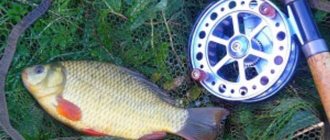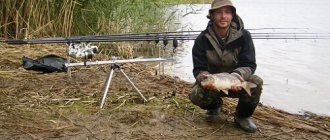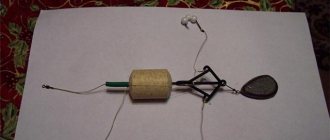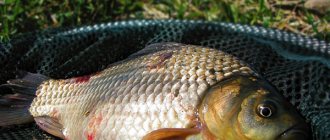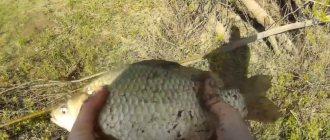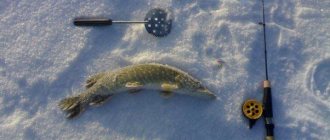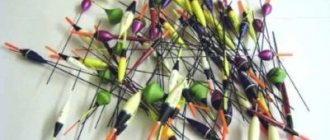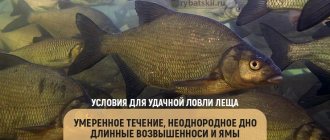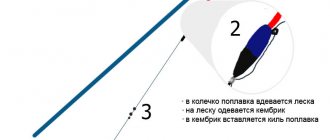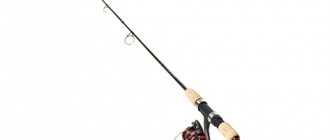Description and characteristic features of golden crucian carp.
Many fishermen know crucian carp, but gold carp is caught very rarely these days. This type of crucian carp is the natural species, from which other varieties have already evolved. Golden crucian carp are very careful fish. Golden crucian carp is a member of the carp family. It differs from carp in the absence of antennae at the mouth and the color of its scales. Golden crucian carp reaches 40 cm in length and weighs up to 1.5-2 kg, in contrast to silver carp, which can reach a length of 45-50 cm and weight up to 3.5 kilograms.
Golden crucian carp develops more in height and grows much slower than silver crucian carp. The body of the golden crucian carp is compressed laterally and strongly curved in height. Its back is dark bronze, and its sides are naturally golden in color. Some individuals are bright orange, which depends on living conditions. The scales are large and clearly marked in color.
This species is very hardy and unpretentious to water. This is one of our fish that can survive in water with a minimum amount of dissolved oxygen (0.6-0.5 cc/l). The minimum amount of oxygen is far from the only achievement of crucian carp for survival in our waters. He is able to survive in an ordinary puddle. But unlike silver crucian carp, golden crucian carp is not found everywhere.
Mostly, golden crucian carp can be found in forest lakes and abandoned peat mines. There is some kind of cyclical development of the crucian carp population in these places. For about 5-6 years, the golden one has a strong presence on large individuals, but after a few years, it seems to become smaller. It is also characteristic of this fish that in some ponds there are only a small number of females. Crucian carp eggs are also fertilized by males of other fish species.
Crucian carp shows amazing adaptability to the temperature of the water in which they live. With no less success, they are found both in the warm waters of reservoirs and in the cold waters of rivers and lakes. In winter, especially in shallow ponds, crucian carp get stuck in the mud and go into suspended animation. If the winter is very cold and the pond can freeze to the bottom, this saves them from death. In general, this is the hardiest type of fish, it is even compared to a cat, which also has nine lives. Wrapped in wet newspaper, crucian carp can survive for up to two days.
Gold
Golden crucian carp (photo will be lower in the article), or, as it is also called, common carp, lives from the Lena River hydrobasin to Eastern Europe. You can find this beauty in rivers, lakes, and small reservoirs such as quarries and ponds. Its presence can be a consequence of the natural migration of the species, or artificial breeding or movement to a particular aquatic zone as a result of reclamation work.
The size of golden crucian carp varies depending on nutrition; in food-depleted places, crucian carp reach only 5–6 cm by the age of two, while in places with an abundance of food they grow into large fish weighing 200–300 g, reaching 25 cm in length. In lakes rich in food for crucian carp or on complementary feeding during artificial breeding, the fish grows even larger in size, gaining up to five kilograms of weight with a half-meter length.
The body of the crucian carp itself is strongly flattened from the sides and at the same time quite high, often the body length is only one or two times the height. Because of this, goldfish are sometimes called round.
Large scales adhere tightly to the skin; there are about 32–35 pieces in a line along the barrels.
The crucian carp has a miniature head, a small mouth and a row of pharyngeal teeth.
The belly of the fish is light in color, and the back is dark, brown in color, with a green tint. The sides are dark gold in color. The fins are paired and may have a red tone.
Golden crucian carp has remarkable abilities to adapt to different environmental conditions from the entire order of the fish family; both its habits and external parameters are plastic.
For example, if there is little food in a reservoir, then crucian carp modernizes its offspring into a dwarf species with a larger head size, a taller body and greatly reduces growth dynamics, and, on the contrary, accelerates sexual maturity, making it earlier.
Under normal conditions, the head of a crucian carp is significantly smaller, the body is lower, and it grows quite quickly.
He just loves muddy, overgrown places. Floodplains and swampy lakes are its most favorite habitats.
It is not very fond of clear waters on the sands, and it is extremely rare to see it there.
The amazing resilience of the fish allows it to successfully survive the winter.
The crucian carp buries itself in the silt and freezes, stops all vital activity, and does not eat.
Even if the reservoir is frozen, it does not die and fully restores its viability after such global cooling. It leaves its winter “den” after the reservoir is completely free of ice, when the water temperature begins to rise.
It can exist for a long time in cold waters, but at the same time stops reproducing. Sometimes it remains the only inhabitant of the water area, where other species simply die under similar conditions.
Usually this fish becomes sexually mature by two years, and in difficult conditions - by four to five years. In males this period begins earlier. Fish spawn in late May or early June, at temperatures not lower than 13 degrees.
Crucian carp gather in schools and are localized in thickets of algae and grass, if we are talking about flooded places. Females lay eggs ranging from ten to one hundred thousand eggs, depending on their age and size.
The eggs are about one millimeter in size or a little more. The spawning period lasts three days. The larvae emerging from the eggs attach themselves to the surface of the vegetation and hang until the yolk sac dissolves.
The larvae are perfectly adapted to respiration, which gives them high adaptive capabilities even in places depleted of oxygen.
The spawning season itself lasts until August, and the female can produce eggs up to four times during this time.
Juveniles feed on planktonic organisms, and as they get older, they gradually spread to insects, larvae, small crustaceans, and aquatic vegetation. The highest feeding intensity of crucian carp is observed in summer.
Golden crucian carp leads a sedentary life and is not inclined to travel, while its caviar, which easily sticks to any surface due to its adhesive shells, can settle on the feathers of birds visiting the surface of a reservoir, moving to other water areas. This explains the sudden appearance of crucian carp where they had not been seen before. This ability, along with vitality and excellent adaptability, is the reason for such a large natural habitat.
Where to catch crucian carp.
We have been fishing for many years, but we still cannot understand the logic behind the activity of crucian carp. You can catch a lot of fish one day, but return to the same place the next day and not see a single bite at all. Of course, this happens with other types of fish, but crucian carp is something special about the capriciousness of fishing. Only on the basis of where there is an overpopulation of crucian carp can we talk about guaranteed success in fishing. However, in these areas, in turn, it is very difficult to expect large samples - more than 1 kg.
Of course, there are several areas where such mining can be assumed. In most cases, they have warm lakes with a large number of large predatory fish that knock out small crucian carp. Thus, it is more likely to find golden crucian carp in some hidden lakes located far from populated areas and hidden in hard-to-reach places.
You can also bet on small, isolated shallow bodies of water, but there is a 1:10 chance that you will find goldfish there. Most likely, you will come across its hybrid, in particular the silver crucian carp. Interestingly, typical small backwaters are not suitable for fish such as bream, roach and carp, as there is very little food for them.
Apparently goldfish can use other food sources and, most importantly, there are periods that are less favorable for other types of fish, for example, extreme heat. Also remember that goldfish can survive winters when the water freezes to the bottom (I'm no expert, but I heard somewhere that crucian carp can produce oxygen from their fat reserves).
I’ll tell you one case that amazed me about the vitality of crucian carp. Once I received crucian carp from a friend in several small plastic bags. I thought they were dead (they had been without water for a long time and did not move). I put the bags of fish in the refrigerator. The next day I would like to use them to catch pike perch. Arriving fishing, so that the fish would not spoil ahead of time, I filled a bucket with water from the lake and poured the crucian carp into it. What was my surprise when after a while, almost all the individuals came to life and began to swim in the water. They were more than 24 hours without water!
Lifestyle
Of all the fish, crucian carp is undoubtedly one of the most unpretentious. Crucian carp lives in more or less significant numbers not only in all lakes and ponds, but is often found in semi-underground lakes, almost completely covered in quagmire, and in small pits, where the life of any other fish other than crucian carp and sleeper is completely unthinkable.
Tina is his element. Here crucian carp obtain food consisting exclusively of organic remains and particles, as well as small worms, and for the winter they completely bury themselves in this silt and survive even in severe snowless winters, when shallow standing waters freeze to the very bottom. There have been examples of crucian carp being dug out alive from the silt of a completely dry pond, from a depth of 70 cm. Golden crucian carp are generally much more hardy than silver crucian carp. Therefore, nowadays you rarely find even the smallest pond or lake in which there would be no bred or accidentally caught crucian carp. The latter, as is known, after a flood are often seen in the smallest basins on water meadows. Sometimes crucian carp appear suddenly in completely isolated pools, but this circumstance can be easily explained by the fact that crucian caviar, sticking to the feathers of water birds, is easily carried even to a fairly significant height and not only develops here into young fish, but these latter, having found themselves abundant food, after a few years they multiply to such an extent that a lake or pond, which until now seemed fishless, after five years is swarming with crucian carp.
In general, crucian carp can be found in any water, and if sometimes it is rare in rivers and several lakes, then this, of course, depends on the fact that at the first opportunity it tries to go into calmer and muddy waters. His thick, clumsy body cannot cope even with a rather slow current, and with a sandy or rocky bottom he has nowhere to get food for himself and nowhere to hide from predatory fish, which take advantage of his clumsiness and soon completely exterminate both him and his eggs and eggs. juveniles
Proof that crucian carp is not at all afraid of cold water can be found in the fact that it is often found, especially in the Ural waters, in spring pits.
Spawning of crucian carp, depending on weather conditions, can begin either in the second half of May or with the onset of early June. Often already in mid-May you can notice a school of frolicking crucian carp not so far from the shore, but such behavior does not bode well for the fisherman. This is how its games manifest themselves during the mating season, and, as a rule, already at this time the crucian carp stops feeding. It is worth noting that in the first days of mating games, the bite of crucian carp is often good, but for a very short time. The closer the end of spring is, the more eggs and milk the crucian carp have to bear, so it is useless to catch crucian carp during the spawning period.
In deep muddy holes, more or less buried in silt, crucian carp spend the entire winter and early spring, and only when the pond or lake is completely cleared of ice do they begin to appear on the reedy shores. Their main exit begins shortly before spawning, when the water has already become significantly warmer, becomes cloudy, when aquatic grasses rise from the bottom and rose hips bloom.
Fishing for crucian carp.
When you find a good area where golden crucian carp lives, it is not a fact that you can catch it. It is imperative to determine a place suitable for fishing. It is best if it is close to the shore and at a depth of 2, maximum 3 meters. Crucian carp are rarely found in open water and generally avoid depth. It prefers to be caught in shallower areas of the lake, in areas where there is some silt or mud. There must be the presence of reeds and other aquatic plants. You need to cast the bait as close to the vegetation or into algae windows as possible. Anglers consider the so-called windows in the seaweed to be a favorite place for catching crucian carp. In the tangle of algae, the crucian carp feels calm. These windows in a continuous carpet of algae give some kind of calm to the fish, despite the real fact that one after another they disappear, falling into our gear. As a rule, good windows for catching crucian carp are created by fishermen themselves, using them constantly. So, if you want to catch crucian carp using ready-made windows, you must be at the fishing spot early in the morning to get a good spot.
There is one peculiarity in catching golden crucian carp. This view never stands in one place. Therefore, after catching a dozen crucian carp, the bite may stop. You should move to another place and re-feed. The fish will begin to gather in a new place again. This probably happens because goldfish are very careful fish.
During fishing, we create some noise, and the fish apparently feel that the number of comrades has decreased. And as a result, a flock of crucian carp leaves this dangerous place. But again it begins to gather in another place. During a day of fishing, with a good bite, you can change a dozen places. Perhaps instinctively the crucian carp is looking for another place of food source.
Fishing Features
Fish are caught mainly with float-type fishing rods, using bloodworms, worms, bread crumbs or pieces of dough as bait. Crucian carp reacts well to odors, so aromatization of the bait with flax, anise, hemp, mint, and laurel oils is successfully used.
In different water areas, fish differ in taste preferences.
Silver, for example, often loves the red worm.
For fishing, the deep parts of the reservoir, which border on overgrown shallow water, are preferred. Crucian carp are taken both from half-water and from the bottom layer, and directly from the surface layer. Fish is changeable in this regard, and one time it can be caught well at depth, and another time it can only be caught from the bottom. You need to find out at what level the bite begins and focus on it.
Here's what you need to know: Cod fishing in the Barents Sea
If in the middle of the summer period the catch of crucian carp is insignificant, then in the period after spawning the fishing goes simply “with a bang.”
The best time for fishing for crucian carp is morning or evening. Fishing is especially successful in good, calm weather.
Golden crucian carp is a less common species among crucian carp. Many ways have been invented to catch it. The most popular are feeder donka, float tackle, winter and summer jigs.
Catching crucian carp using feeder gear
Crucian carp can be caught with the simplest gear, but when fishing from the bottom you should give preference to a feeder. These are “bottom” equipment, most often using feeders.
The feeder and picker are convenient for most, even inexperienced anglers. They allow the fisherman to be quite mobile on the pond, and thanks to the possibility of targeted feeding, quickly “collect” fish in a given place.
Feeder and picker, as separate types of equipment, currently differ only in the length of the rod. The basis is the presence of a bait container-sinker (feeder) and replaceable tips on the rod.
The tips change depending on the fishing conditions and the weight of the feeder used. Fishing baits can be of any kind: both plant and animal origin, including pastes.
This fishing method is available to everyone. The tackle does not require additional accessories and specialized equipment.
This allows you to fish in almost any body of water. It is worth paying attention to the choice of feeders in shape and size, as well as bait mixtures.
This is due to the conditions of the reservoir (river, pond, etc.) and the food preferences of local fish.
Catching crucian carp with a float rod
It is during spawning periods that crucian carp are caught using nets and other gear. In many reservoirs, most crucian carp are caught using wall meshes.
Such fences are usually placed near the reeds where, according to experience, they go to spawn. When the place and time are chosen successfully, such a number of fish are caught that the net literally goes to the bottom.
There are cases where up to 10 pounds of excellent fish are taken out of any mesh in one morning.
In addition, large numbers of crucian carp are caught at different times of the year, excluding winter, in the snout device. An oblong cone-shaped jug woven from willow branches is called a muzzle, top or nerot. In the middle of a wide cone-shaped hole, a throat is woven from twigs like a funnel, so that the fish can freely pass into the muzzle, but cannot get out.
Some fishermen put some kind of bait, such as bread, in such gear. You can even catch crucian carp in a laundry basket tightly closed with matting or a lid with a hole about 2 inches in diameter. Place a bag of cottage cheese in this basket, then put it in water, placing a stone, usually overnight.
As a rule, crucian carp is caught using a float rod. Catching crucian carp with a float rod is quite an exciting experience.
And here's what you need to know: What to use to catch rudd? The best baits and lures
When fishing, you should use light tackle and a long rod, since the muddy banks of reservoirs do not always allow you to get close enough to the water. The hook should be size 3-6, the fishing line should be no thicker than 0.2 mm.
The sinker and float should be made so that it is possible to install a hook with bait at any depth.
Part 1
Part 2
We'll probably end here. I wish everyone successful fishing for crucian carp!
Anecdote: A fisherman is walking and dragging behind him a hefty catfish, about 100 kilograms. The poor thing is already hunched over. And then another fisherman comes to meet him with a bucket of crucian carp. He looked at him and said so sarcastically: “What, I only caught one...?”
Groundbait and bait for crucian carp.
Crucian carp is a characteristically bottom-dwelling fish. His main rule is to look for food by digging at the bottom in the mud. At the same time, crucian carp will not miss larvae, worms, small leeches and even small fish. This is a frankly omnivorous fish. In the warm season, crucian carp graze with visible pleasure in algae or feast on young shoots of sycamore and reeds.
This happens mainly in the evening, and in calm weather a clear slurping sound can be heard throughout the pond. First of all, we find a quiet deep bay on the lake. We throw five or six large, orange-sized balls of soaked bread into the chosen fishing spot, to which we add a little clay for cloudiness. As a rule, after half an hour, crucian carp begin to gather at the feeding site. Then we only need to regularly toss small balls of bait with added bait, which is used to catch crucian carp.
As a rule, goldfish are well caught using bait of animal origin: dung worms, maggots, dragonfly larvae, shitika and other insect larvae. Large crucian carp are sometimes well caught on boiled or canned corn and peas. But it is best to use animal bait.
If the crucian carp takes very poorly and slowly, try catching it with a croissant or a couple of maggots. You can try other baits designed for catching other carp fish. Do not use hard baits such as sweet corn, wheat or oatmeal as bait. These baits are good for bait, since it is difficult for crucian carp to bite such hard food. Crucian carp loves soft baits.
Thus, it can be assumed that crucian carp prefers food of animal origin; it will be more picky about plant foods. To better attract crucian carp, you need to add maggots and chopped worms to the bait. It is good to add bone meal, which with its strong smell perfectly attracts a school of crucian carp.
Vegetable bait for crucian carp should only be very soft and in small pieces, such as pellets of bread or very soft dough. Of course, we can assume that large crucian carp can be caught using larger and harder bait. But still, the ideal and best bait for crucian carp would be an earthworm, as well as a dung worm.
Pond crucian habitats
As a rule, the habitats of golden and silver pond crucian carp are the same bodies of water, but fish with a golden body color can calmly frolic in places where silver crucian carp find it difficult to survive.
Populations of golden crucian carp reproduce quickly in silty enclosed reservoirs and do not live in rivers, while fishing for silver crucian carp on the weak currents of some lowland rivers is common.
Golden crucian carp is extremely hardy, can live and reproduce in a heavily silted pond overgrown with algae, peat excavation, oxbow lake, ditch with a minimum oxygen content in the water.
Pond silver crucian carp is less adapted to survival than golden crucian carp; the result of catching this fish largely depends on the weather conditions and the comfort of living conditions in the pond.
Catching small gold and silver crucian carp in small ponds with a poor food supply (see photo) with live bait can be promising throughout the daylight hours.
True, recently silver and golden crucian carp are everywhere being replaced by rotan, which eats everything that can move. Therefore, where rotan lives in addition to crucian carp, it is better to use plant baits for fishing.
Habitats of crucian carp in small ponds
In small ponds with a poor food supply, the habitats of golden crucian carp are areas with a muddy bottom and soft algae - a source of food for golden fish. Pond carp periodically require a different food supply to gain weight.
In winter, golden carp burrow deep into the silt and can survive even in shallow bodies of water that freeze to the bottom. In the same way, unpretentious fish can wait out a dry summer in the silt.
It is thanks to its endurance that golden crucian carp can be the only inhabitant of small and shallow ponds and lakes, where its fishing can be successful throughout the summer.
To breed pond goldfish, a more comfortable habitat with greater depths, feeding areas with food of animal origin, and spawning grounds more suitable for breeding is needed.
For the spring season, various kinds of larvae living in the pond will be the best baits used for catching crucian carp.
Tackle for catching crucian carp.
The most common way is to catch crucian carp using a fishing rod with a float. In this case, it is enough for us to fish with a lightweight universal telescope without drivers. The main line can be thicker - about 0.16-0.20, but the leash is always thin - 0.12. Hooks for catching crucian carp need white colors No. 14 - No. 10.
If we want to expand the perimeter of catching crucian carp and make long casts, a telescope with a reel is suitable. With this version of the fishing rod, use a removable float. The thickness of the main line is in the range of 0.16-0.20, use the same leashes and hooks as for a float rod. Sinkers are installed at a distance of 25-30 cm from the hook.
When fishing for crucian carp in reservoirs, use tackle with two leashes about 15 cm long. With this fishing method, the main line can be up to 0.24-0.30 thick, but the leashes must be made up to 0.14 thick. There is another fishing option: catching crucian carp from the bottom. We are talking about classic cake fishing. In this case, bottom tackle is used to catch carp and bream.
Fishing for silver pond carp
Fishing for silver pond carp in the heated shallows of enclosed reservoirs begins before spawning in the spring after the bulk of the melt water has disappeared.
After spawning, the most promising areas for catching fish with silver scales shift to deeper areas of the pond.
In not hot summers, the optimal depth for catching silver crucian carp on most pond farms does not exceed one meter.
The photo shows a typical example of a shallow pond area overgrown with algae, quite suitable for catching silver crucian carp in the summer with the simplest fishing rod and float.
The bait is thrown behind an island of duckweed grass washed up on the shore. True, the results of pond fishing for gold and silver crucian carp in each individual pond in the summer can be very variable.
Today, silver crucian carp can be caught with almost any bait that is familiar to it in a given body of water. And tomorrow, without any visible signs of a change in the weather, we can go around the pond and catch just a few small silver carp.
Often, in certain areas of the pond, gas bubbles can be observed on the surface of the water, which is a sign of silver crucian carp feeding from the bottom of the reservoir. But this does not mean at all that it will definitely be caught on our baits.
Time to catch crucian carp in summer
But the next day, in the same place in the pond, pond crucian carp can be caught continuously for several hours. The best time for summer fishing for silver crucian carp in hot, stable weather is late evening, night, early morning.
And, nevertheless, experienced fishermen, having studied the lifestyle of silver crucian carp on a particular pond, selecting appropriate baits, baits and gear depending on the time of day, year and fishing conditions, will catch silver crucian carp much more effectively than novice fishermen.
How the crucian carp bites and the visibility of the bite.
The golden crucian carp has a small mouth. He slowly and carefully tries the bait he likes. Sometimes, especially with bakery baits, he can fiddle with it for an indecently long time, creating the appearance of a bite. When fishing for crucian carp, you can often observe how the float trembles slightly and sways from side to side. A crucian carp approached the bait and carefully tried it.
However, on wild lakes, golden crucian carp does not stand on ceremony for a long time. His bite is similar to the swift blow of a perch; he grabs the bait with a running start and tries to quickly hide with it in a secluded place. If your reel clutch is poorly adjusted or the line is too thin, a break will naturally follow. When fishing for crucian carp on forest lakes, you must always be on alert.
Golden crucian carp is a very strong fish, unlike silver crucian carp. Under no circumstances should the line be slack. The goldfish has an upper fin like a razor blade. Sensing a slack in the tension of the tackle, it immediately turns over around its axis, thereby cutting your line with its dorsal fin. Another way of biting involves smoothly moving the float to the side. The crucian bite is similar to the line bite. Also, the float can suddenly lie on the surface. In such cases, you need to immediately hook the crucian carp.
Silver
Silver crucian carp lives in the reservoirs of Eastern Siberia, in the Pacific Ocean, and in rivers flowing into the Aral Sea.
To date, fish have populated many flowing and closed water bodies.
By the beginning of the second year of life, silver crucian carp grows up to ten centimeters, gaining a weight of about 30 grams. In the fifth or sixth year, he can gain a kilogram weight with a length of 30 to 40 cm.
The pharyngeal teeth are in one row, and the large, tightly fitting scales in the lateral lines number 27–33.
Crucian carp has a more elongated body, a longer intestine, and gill rakers on the first arch are also present in greater numbers than those of its golden counterpart. The caudal fin has a larger notch, and the dorsal fin is noticeably longer.
The sides and belly are silvery, and the back is dark, almost black.
Silver crucian carp can be found in large lakes and rivers, in flowing reservoirs, but it still prefers stagnant waters or with a slow flow. It loves muddy bottoms and leads a sedentary, bottom-dwelling life.
It easily survives when a pond freezes; in winter, the species is localized in deeper places. In the spring, after the ice melts, it comes out into shallow water warmed by the sun. By May-June it forms groups for spawning. And starting in autumn, it looks for places for wintering and moves to greater depths. Silver crucian carp also overwinter in groups.
It reaches sexual maturity by three to four years, and if living conditions are optimal, then even earlier, upon reaching 18 cm in length or more.
It spawns according to the same pattern as golden crucian carp; the spawning period itself lasts longer than that of golden crucian carp. Egg throwing requires a water temperature of at least 16 degrees; the female releases portions of eggs ranging from 90 to 650 thousand eggs.
Often, goldfish reproduce through hypogenesis, when only the nucleus of the egg is determined in the development of the embryo, which leads to the appearance of exclusively female individuals.
During hypogenetic reproduction, eggs can be inseminated by related fish species. For example, silver crucian caviar is inseminated with sperm from carp, golden carp, tench, loach and others. In this case, the offspring tend to inherit only the original maternal physical parameters, that is, hybrid forms cannot be obtained with such crossing.
Therefore, in the population of silver crucian carp there is usually a sharp preponderance in numbers towards females. There are populations where there are no males at all. This ratio is quite rare in other fish.
Silver crucian carp that reproduce by hypogenesis have a triple set of chromosomes, while fish with bisexual reproduction have only two chromosome rows.
The silver variety feeds in the same way as the common crucian carp, ceasing all vital activity for the winter.
The dynamics of growth also depend on conditions, but if we take it on average, the rate of gain in length and weight is low. By the age of six, with abundant feeding, it can gain up to a kilogram.
It is not inclined to long-distance migrations, but nevertheless, due to its resilience and adaptability, it has populated a fairly vast area of water.
What’s interesting : this particular variety of crucian carp is the forerunner of the goldfish so beloved by aquarists, artificially bred on the basis of its genetic material.
And from it a whole range of decorative forms of fish, varying in size and appearance, was created. It is surprising that the vitality of crucian carp allows, if the reservoir dries out in the summer, to go into a layer of silt and wait there for quite a long time until the reservoir is restored, since it can make do with a minimal percentage of oxygen.
Fishing for crucian carp.
Golden crucian carp is a strong fish. And since he has a small and very weak mouth, you must very carefully try to bring him to the landing net. Since this fish is mainly caught in overgrown ponds and lakes, there are difficulties in guiding it through algae and vegetation. The crucian carp is constantly trying to escape into the grass. If he succeeds, he is the winner of the fight. It is almost impossible to pull a crucian carp out of the grass. This must be taken into account when catching and playing.
However, the same size as carp or carp, crucian carp is still at least two times weaker than them, but fights quite intensely. The most important thing after hooking is to not let the crucian carp go into the thickets of grass or reeds and keep the line constantly under tension. When catching larger specimens we need to be more careful.
After resting a little, the crucian quickly gets tired and lies flat on the water. Here we can celebrate victory with confidence. Although there were cases that at the moment of putting fish into the landing net, a large crucian carp made a final push, and often broke off the leash, since the fisherman was already in a relaxed state, having decided that his catch was already in the cage.
Habitats and catch
It is well known that crucian carp lives almost throughout the entire territory of our country. This fish prefers places with very weak currents and swampy lakes. That is why this fish can be found in almost all small lakes. Experts say the best sign of the presence of this species is mud on the water. In rivers, crucian carp can only be found next to the bank, which is overgrown with reeds. It is in its thickets that crucian carp lives .
Representatives of this species are not afraid of serious frosts, so they often live in reservoirs that completely freeze in winter. Crucian carp are also often bred in artificial reservoirs. In many regions there are large farms that raise this fish for sale.
This species is caught exclusively in the warm season. This is due to the fact that crucian carp go deep under water during the winter. Usually, it burrows into the mud at a depth of 40–60 centimeters. Individuals rise to the surface only after the onset of heat. Some fishermen say that fishing should begin only after the rose hips begin to bloom. This is due to the fact that by this time the water temperature rises above 12 degrees Celsius.
Fishermen say that you should start fishing for this type of fish only after sunset. In hot weather it will not be possible to catch a catch. Some fishermen begin fishing only at dawn. They claim that many large specimens can be caught at this time. As a rule, when fishing, they use a regular bottom fishing rod. The bait chosen is a worm, maggot or dough. Some fishermen also use bait. They say that this allows them to increase their catch several times. As a rule, porridge is used as bait, which is slightly flavored with vegetable oil. It is best to choose anise or sunflower oil . Crucian carp also like the smell of vanillin .
Crucian carp fishing - conclusions.
Despite the widespread prejudice and even disdain of some fishermen towards crucian carp fishing as a serious fishing activity, many specifically look for hidden places to catch gold crucian carp. This species of crucian carp is now becoming very rare. If you compare catching gold with silver, these are two big differences. Golden crucian carp is very interesting in terms of fishing.
Firstly, it can be said that it is a rare fish, and secondly, in terms of its beauty and active resistance, golden crucian carp can be compared with the carp’s wild brother - the carp. Under good circumstances, such as the discovery of a lake or pond with golden crucian carp, the right choice of bait and fishing location, the catch can be very significant. In general, this is a fish worthy of respect, without big complaints, although many fishermen do not perceive crucian fishing as serious fishing.
Eating
Golden crucian carp has always been in demand among fish lovers. This is due to this tender, sweetish meat. In addition, its meat contains many vitamins, such as:
The calorie content of this type of fish is considered low, since 100 grams contain only 87 kilocalories. The fat content does not exceed 2.5 grams per 100 grams of meat.
When buying crucian carp, you must pay attention to the eyes. In stale fish they are quite cloudy. You should also always look at the gills. If they are very dark, it means the catch has been sitting on the counter for a very long time. A strong smell is also a signal to refuse a purchase.
Most housewives know several recipes. The easiest way is to fry this fish. Small crucian carp need to be gutted and scaled. Then the fish must be salted. Fish should be fried in vegetable oil. If the fish is quite large, then it is worth cutting it into pieces so that they fry faster.
A favorite dish of many people is crucian carp baked with sour cream. To prepare this dish you need to buy the following products:
- carcass, weighing 1 kilogram;
- onion;
- sour cream;
- salt and spices.
The fish must be cleaned and gutted. Then the meat should be salted. The onion needs to be finely chopped and placed in the belly of the fish. Then the carcass should be placed on a baking sheet and poured with sour cream. Bake the crucian carp for no more than 30 minutes so that it does not become too dry.
Culinary qualities of crucian carp.
The meat of golden crucian carp is very tasty, unlike silver crucian carp. This is probably because golden carp is a wild fish, lives in clean waters and eats natural food. Crucian carp is very tasty in any cooking method. It’s not for nothing that our great-grandfathers loved this dish – crucian carp in sour cream. I tried it myself more than once. Real jam!
Small crucian carp up to 100 g, fried whole on both sides. Cut larger ones in half along the spine. This way they become thinner and cook better, and the bones soften better. Very large crucian carp are baked in an oven or on a grill, since the meat between the ribs is considered the most delicious. Unlike silver crucian carp, golden crucian carp does not have a specific taste of mud and algae, since it lives in clean lakes and feeds mainly on animal food. For a delicious taste, it is good to soak crucian carp in milk before frying.
And, finally, a pleasant feature of crucian carp - often in the catches there are, for some reason, female crucian carp, which have a lot of caviar all year round. Crucian caviar is no different from carp caviar. After removing the caviar from the fish, peel it. Wash and dry it, then salt it and put it in a jar. Keep in the refrigerator for about 2 weeks until the caviar takes on an orange-golden color.
Features of development
Golden crucian carp has amazed many fishermen with its appearance. It is distinguished by the beautiful golden color of its scales. Individuals of this species have an almost round body with a small tail and a small head. The fins of this type of fish are quite small. This is due to the fact that individuals do not mix over long distances. Juveniles have a small dark spot near the caudal fin. After reaching puberty, the spot disappears.
Crucian carp is considered a small fish. The weight of an average individual does not exceed 500 grams. Of course, some fishermen managed to catch large specimens, weighing up to three kilograms. Quite large crucian carp are found in the Cheboksary Reservoir. The average lifespan of representatives of this species is 10 years, but specimens that have reached 15 years of age are often caught.
The diet of crucian carp greatly affects its weight. That is why in those reservoirs in which the population is high, the weight of individuals is quite low. This is due to lack of food. Individuals mainly feed on small insects and larvae.
